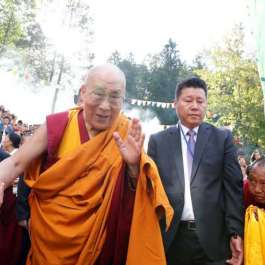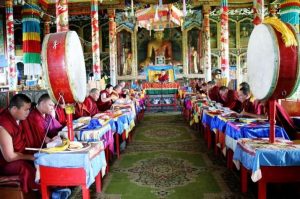
The Buddha and his disciple Ananda had many conversations that often turned into teaching moments. The Pali Canon is full of their interactions, including a memorable one in which Ananda stated:, “This is half of the holy life, lord: admirable friendship, admirable companionship, admirable camaraderie.”
The Buddha responded:
Don’t say that, Ananda. Don’t say that. Admirable friendship, admirable companionship, admirable camaraderie is actually the whole of the holy life. When a monk has admirable people as friends, companions, and comrades, he can be expected to develop and pursue the Noble Eightfold Path.
(Upaddha Sutta SN 45.2)
Friendship is often overlooked in a society that places great emphasis on romantic partnerships and family ties. But let’s go with the Buddha’s observation that friendships are, indeed, the whole of the holy life. How are spiritual friendships different from secular friendships? What does it mean to be a good friend to another? What qualities do you appreciate in your good friends, and how do they support your spiritual path?
I’ve always felt a special kinship with the idea and practice of friendship, perhaps because I haven’t been so good at those other kinds of relationships. But I seem to excel at being a good friend. My teacher, Victoria Shosan Austin, even gave me a Dharma name that carries that meaning within it: Zenyu. In her process of preparing to transmit the precepts, she takes time to speak with people who know the person well and tries to discern qualities that are present and qualities that are to be encouraged and cultivated. Prior to my jukai ceremony, everyone Shosan spoke with seemed to mention a different aspect of the “me” that they knew, but the common thread was that I was a good friend. So she kept it simple and gifted me with that name. I continue to feel into what that means and how I can settle even more deeply into being a good friend—to others as well as to myself.
Over the years, I’ve noticed how friendships in the context of Dharma practice have a different flavor to them. There are the basics of being a good friend, as I understand them: listen well, offer support as appropriate, be ready to have fun together. While Dharma friendships include all of these elements, there is another layer.
The listening serves as a way to allow a friend to actually hear themselves more clearly, to perhaps discover a part of their truth which may have been obscured. Offering support becomes more nuanced, as I get to know them over time and gain a better understanding of the kind of support that could be helpful and the kind that could be counterproductive or even enabling. Having fun is pretty simple and not all that different in those two kinds of friendships—but something about knowing each other’s path fairly intimately often means the experience of “fun” becomes even more vibrant. When you’ve been there to bear witness to each other’s darkest moments, those episodes of fun can be wildly cathartic.
I asked Shosan to share her understanding of Dharma friendship. She shared with me: “Kalyana-mittata is the relational basis of sangha refuge. . . Kalyana-mittata is metta in action. As concentration and meditation is the mind of practice, kalyana-mittata is the heart.”
I think a lot about my friend Katya and our connection to each other, which lasted eight years, as a beautiful container for a Dharma friendship. She showed up for me in more ways than I can count, beginning in the early stages of our friendship with the very practical offering to take care of my dog when I needed to get away. As we grew to know each other and our shared commitment to mindful awareness as the basis of our lives, we sat meditation alongside each other in both formal and informal settings. She listened to my confusion and desperation around relating to my elderly parents. Katya never offered “advice.” Rather she listened deeply and reflected the difficulties she was hearing me express in a way that shed new light on them for me. Gradually I found a pathway through those difficulties that was illuminated by that understanding.
It wasn’t all bliss. Katya and I would bump up against each other’s edges. At times we’d irritate each other; we’d confound each other. But there was a way that we kept each other’s buddha-nature at the center of our connection, and understood we were both learning, always. This aligned with something else Shosan shared with me:
Traditional descriptions of Kalyana-mittata and metta emphasize their positive aspects. We need to understand, though, that our obstacles, conflicts, difficulties, and challenges are how we grow. We need to know how in good spiritual friendships there is the possibility of feeling annoyance, staleness, burnout, competitiveness, and many other negative emotions, as well as ally-ship, beauty, and support.
Good spiritual friends know and care about each other’s history, limitations, contradictory habits, and so on. They practice safe holding. So it isn’t the feeling of beauty and light that is most important for the practice of good spiritual friendship, but rather how transparent we are, and what we say and do with each other in the full range of relational experience, for and with all beings.
When Katya was diagnosed with stage IV cancer in 2021, it was crystal clear to me that my responsibility as a Dharma friend was to do everything possible to support her journey with cancer and her walk “home.” She died in September of that year. Perhaps another quality of a Dharma friendship is to sense into its enduring nature, discovering how it does not end at death but continues to unfold in our lives in mysterious and beautiful ways.
Another person who comes to mind as a dear Dharma friend is Shosan. Those same qualities are present in that relationship, although we have had almost no in-person time together these past few years between living in different US states, the COVID-19 pandemic, and health issues. Still, the connection has felt strong since 2001, when I first asked Shosan if she would be my teacher.
How does this kind of friendship intersect with the dynamics of a teacher-student relationship? Once again I turned to Shosan, curious to hear her thoughts. Her response:
All sangha relationships include a horizontal and a vertical transmission of the path. Kalyana-mittata emphasizes horizontal transmission. Given our own histories, the form of our lives and psyches, how does the dharma arise hand in hand in a relationship with the other? How do we realize “not one, not two” in our aspect of equality as humans impacting each other?
The teacher-student relationship emphasizes generational, or vertical, transmission. However, without Kalyana-mittata as a basic way that two hearts meet as human equals, the vertical transmission is dry. We need to know that the teacher is the teacher, and the student, the student. But first we are humans together fulfilling the vow, and requiting the light of Buddha.
In my own understanding of Buddhism, the prime directive is to not turn away from suffering, not our own and not that of our fellow humans and all beings. That’s the vow I’ve taken and that is how I try to keep the light of awakening alive. Within the container of a Dharma friendship, we can practice by noticing when one of us is about the veer off that path, which is so easy to do, and lovingly call each other back with gentle accountability. What an immeasurable gift that kind of friendship is.
References
Thanissaro Bhikkhu, trans. 2013. “Upaddha Sutta: Half (of the Holy Life)” (SN 45.2). Access to Insight (BCBS Edition), http://www.accesstoinsight.org/tipitaka/sn/sn45/sn45.002.than.html.
Related features from BDG
Daughters of the Buddha: From Banking to Buddhism – A Conversation with Gelongma Pema Deki
Cultivating True Friendship in the Age of Social Dilemma
Themes of Dialogue: Turkish culture, Buddhism, and Muslim friendship
Perfections and Imperfections on the Noble Path
All Buddhists Belong to the Same Family
Delta Beta Tau at San Diego State University: The Nation’s First Buddhist Fraternity













